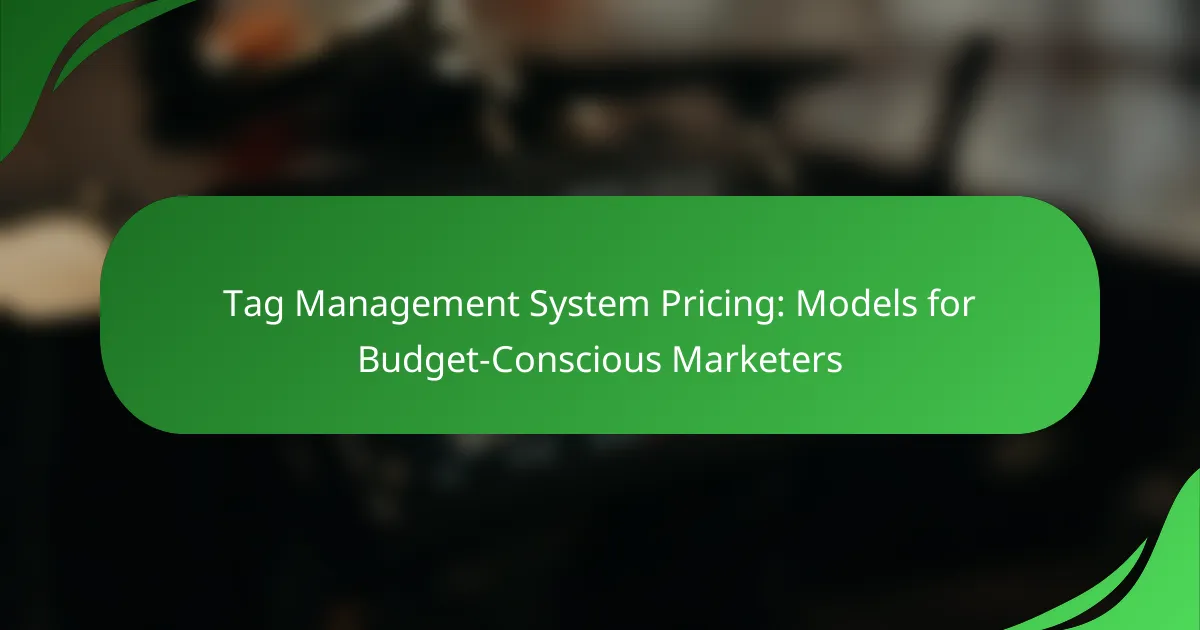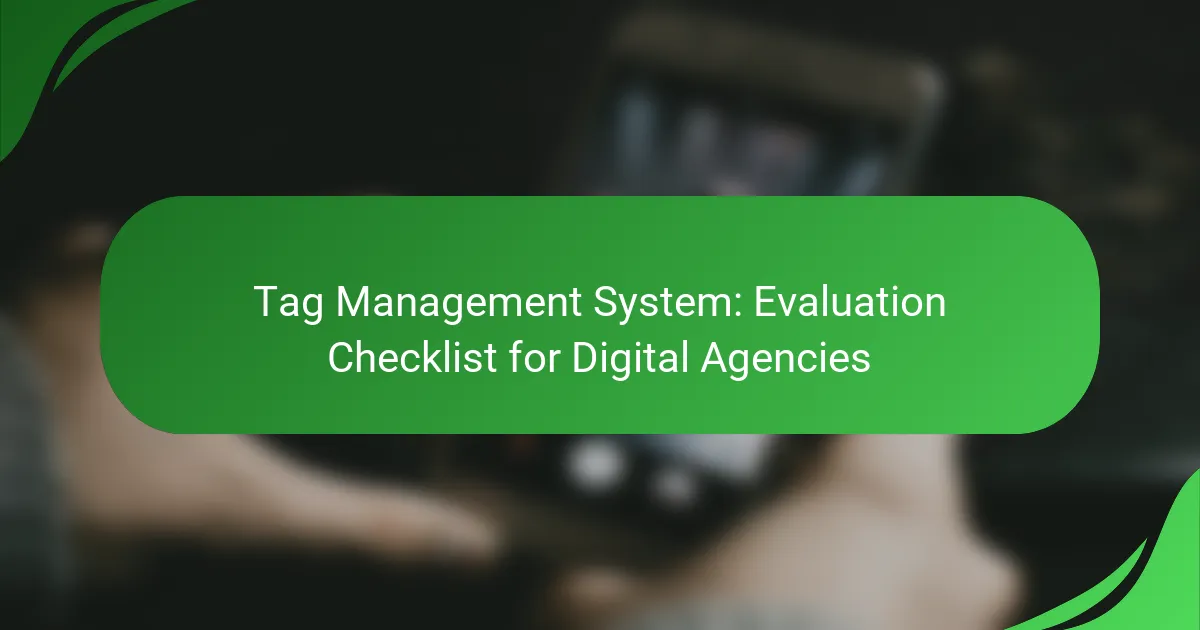Tag management systems (TMS) offer a variety of pricing models designed to meet the needs of budget-conscious marketers. By understanding the factors that influence costs—such as features, scalability, and support options—marketers can make informed decisions to find the most cost-effective solution for managing their tags. This guide will explore the available pricing structures to help you navigate your options effectively.

What are the pricing models for tag management systems in Canada?
Tag management systems (TMS) in Canada typically offer several pricing models to accommodate different budgets and needs. Understanding these models can help marketers choose the most cost-effective solution for managing their tags.
Subscription-based pricing
Subscription-based pricing is a common model where users pay a recurring fee, often monthly or annually, for access to the TMS. This fee usually covers a set number of features and support options, making it easier for marketers to budget their expenses.
Prices can vary widely, typically ranging from a few hundred to several thousand Canadian dollars per month, depending on the features included. Marketers should assess their needs to determine if a basic plan suffices or if a premium option is necessary.
Pay-as-you-go pricing
Pay-as-you-go pricing allows users to pay only for the tags or features they use, making it a flexible option for those with fluctuating needs. This model is particularly beneficial for smaller businesses or projects with limited budgets.
Costs can vary based on usage, but marketers should be aware that while this model can save money in the short term, it may become more expensive if usage increases significantly over time.
Freemium models
Freemium models offer basic features for free, with the option to upgrade to a paid plan for more advanced capabilities. This model is ideal for marketers who want to test a TMS before committing financially.
While the free version may suffice for small-scale operations, users should evaluate whether the limitations could hinder their marketing efforts as their needs grow.
Enterprise pricing
Enterprise pricing is tailored for larger organizations with extensive requirements. This model often includes custom features, dedicated support, and advanced analytics tools, reflecting the complexity of enterprise-level needs.
Costs for enterprise solutions can vary significantly, often starting in the low thousands of Canadian dollars per month, and may require negotiation based on the specific needs of the organization.
Tiered pricing structures
Tiered pricing structures offer multiple plans at different price points, allowing users to choose a package that best fits their needs and budget. Each tier typically includes a set of features that increase in value as the price rises.
Marketers should carefully compare the features of each tier to ensure they select a plan that provides the best balance of cost and functionality for their specific tagging requirements.

How do tag management system costs compare?
Tag management system costs vary significantly based on features, scalability, and vendor. Budget-conscious marketers should consider both free and paid options, weighing the trade-offs between functionality and pricing to find the best fit for their needs.
Google Tag Manager vs Adobe Launch pricing
Google Tag Manager (GTM) is a free tool that offers robust features for managing tags without incurring direct costs. However, users may face indirect costs related to training or integration with other tools.
In contrast, Adobe Launch operates on a subscription model, which can range from hundreds to thousands of dollars annually, depending on the level of service and features required. This investment may be justified for organizations that need advanced capabilities and support.
Tealium pricing analysis
Tealium’s pricing is typically based on a tiered subscription model, which can vary widely based on the number of tags and data sources integrated. Costs can start in the low thousands of USD per year and increase significantly for enterprise-level solutions.
When considering Tealium, assess your organization’s size and tag management needs to determine which tier aligns best with your budget. Keep in mind that while Tealium offers extensive features, the investment may not be suitable for smaller businesses with limited budgets.
Segment pricing overview
Segment operates on a usage-based pricing model, where costs depend on the volume of data processed and the features utilized. Basic plans may start at around $120 per month, while advanced features can lead to costs in the thousands monthly.
Marketers should carefully evaluate their data needs and expected growth when selecting a Segment plan. This approach helps avoid overpaying for unused features while ensuring that essential capabilities are included in the chosen package.

What factors influence tag management system pricing?
Tag management system pricing is influenced by several key factors, including the number of users, the volume of tags, integration capabilities, and support and training options. Understanding these elements can help budget-conscious marketers make informed decisions when selecting a system that fits their needs.
Number of users
The number of users who will access the tag management system can significantly impact pricing. Many providers offer tiered pricing based on user count, with costs increasing as more users are added. For small teams, plans may start in the low hundreds of USD annually, while larger organizations could face costs in the thousands.
When evaluating user-based pricing, consider how many team members need access and whether all users require full capabilities or if some can operate with limited permissions. This can help optimize costs.
Volume of tags
The volume of tags you plan to manage is another crucial factor in pricing. Most tag management systems charge based on the number of tags deployed, with basic plans accommodating a limited number and higher tiers supporting larger volumes. For example, a plan might allow up to 100 tags for a lower price, while plans for thousands of tags can be significantly more expensive.
Assess your current and future tagging needs to choose a plan that aligns with your expected growth. Overestimating tag volume can lead to unnecessary costs, while underestimating may result in needing to upgrade sooner than anticipated.
Integration capabilities
Integration capabilities can also affect the pricing of tag management systems. Systems that offer extensive integrations with popular marketing tools and platforms may come at a premium. If your organization relies on specific software, ensure the tag management system can integrate seamlessly to avoid additional costs for custom solutions.
Evaluate the integrations you need and consider whether a more expensive system with robust integration options might save you money in the long run by reducing manual work and improving efficiency.
Support and training options
Support and training options can vary widely among tag management systems and influence overall costs. Some providers include basic support in their pricing, while others charge extra for premium support or training sessions. Budgeting for these services is essential, especially if your team is new to tag management.
Consider the level of support your team will require. If you anticipate needing extensive training or ongoing assistance, it may be worth investing in a plan that offers comprehensive support to ensure successful implementation and usage of the system.

What are the benefits of using a tag management system?
A tag management system (TMS) streamlines the process of managing and deploying marketing tags on a website, enhancing efficiency and accuracy. By centralizing tag management, marketers can improve website performance, ensure data accuracy, and expedite the deployment of marketing tags.
Improved website performance
Using a tag management system can significantly enhance website performance by reducing page load times. A TMS allows for asynchronous loading of tags, which means that tags can load independently of the main content, minimizing delays for users.
Additionally, by consolidating multiple tags into a single container, a TMS can decrease the number of HTTP requests, further improving load times. This is particularly beneficial for sites with numerous tracking and marketing tags, as it helps maintain a smooth user experience.
Enhanced data accuracy
Tag management systems improve data accuracy by providing a unified platform for managing all tracking codes. This reduces the risk of errors that can occur when manually adding or updating tags across various platforms.
Moreover, a TMS often includes built-in validation tools that help ensure tags are firing correctly. This means marketers can trust the data collected, leading to better-informed decisions based on reliable analytics.
Faster deployment of marketing tags
With a tag management system, marketers can deploy new marketing tags quickly without needing extensive IT support. This agility allows for rapid testing and iteration of marketing strategies, which is crucial in today’s fast-paced digital landscape.
Typically, adding or modifying tags can be done in a matter of minutes through a user-friendly interface. This quick turnaround can lead to improved campaign performance and responsiveness to market changes.



